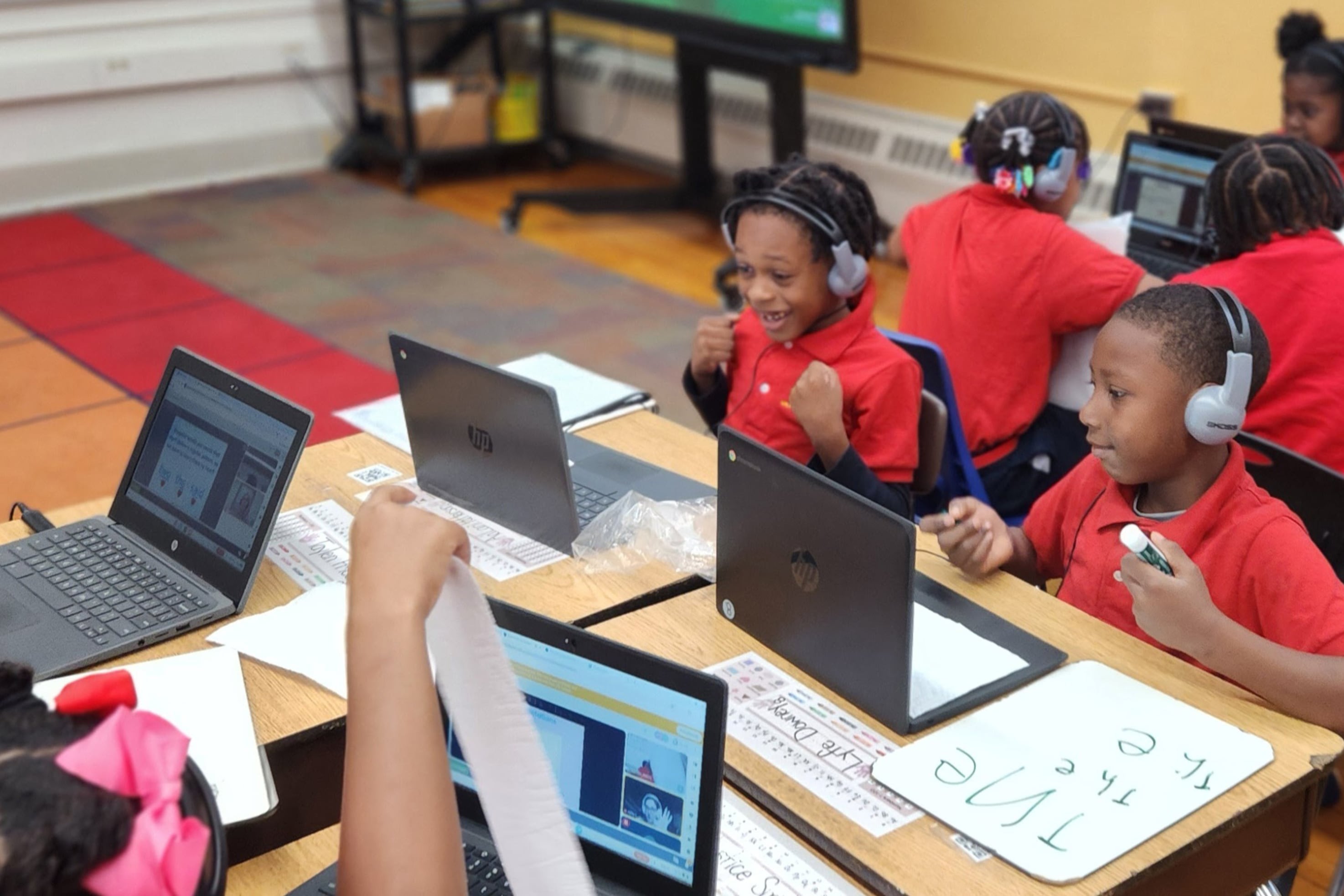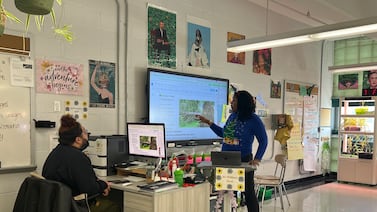Sign up for Chalkbeat’s free weekly newsletter to keep up with how education is changing across the U.S.
Three times a week, the young students struggling the most with reading at each of Milwaukee College Prep’s four campuses go to a dedicated classroom, don their headphones, and log into a virtual tutoring session.
For the next 30 minutes, each student gets one-on-one attention from a certified teacher who might ask them about their dog or their baby sister before diving into the lesson.
Virtual tutoring — in this case through a provider called OpenLiteracy — is the only way Milwaukee College Prep could provide so much tutoring for so many children and from such experienced educators, said Erica Badger, director of curriculum and instruction for the 2,000-student charter network.
“We have a hundred kids on at once,” she said. “Being able to have that many adults come into the school building? I can’t even imagine.”
For these reasons and others, virtual tutoring has remained part of the toolbox of American schools long after students returned to in-person classes. It costs less than in-person tutoring, scheduling is more flexible, and providers aren’t limited to hiring in the surrounding community.
But it doesn’t always work smoothly.
Two studies from Stanford University’s National Student Support Accelerator released Wednesday used natural language processing technologies to review transcripts from tens of thousands of hours of virtual tutoring sessions. Their goal: to better understand exactly what happens between tutors and students in these sessions.
One study examines the impact of disruptions as revealed through tutor comments, such as “You can’t see me? I’m not sure why you can’t see me” or “Sorry. Did you say something? It was hard to hear.”
Researchers found that 19% of available time was lost to disruptions, whether from technological issues, distracted students, or background noise. Time lost to disruptions was even greater when tutors were working with more than one student, especially if one of the students entered the session late.
The other study looked at how tutors divide their time and build relationships with students in one-on-one sessions and in sessions with two students.
Students were randomly assigned to either an individual tutor or to work with the tutor and another student. Tutors spent more time talking overall when they were working with two students, but only about 21% of tutor speech was individualized content instruction, compared with 65% one-on-one sessions. The tutors in the one-on-one sessions also used more phrases associated with motivation and relationship-building.
Both studies involved young students working on early literacy skills.
High-intensity or high-dosage tutoring, generally defined as occurring at least three times a week and for 10 weeks or longer, emerged as one of the most high-profile and effective interventions to address pandemic-related learning loss. But large-scale tutoring programs haven’t always produced the same outcomes as carefully designed pilot programs.
The new studies shed light on why virtual tutoring in particular has a mixed track record, according to studies. They also suggest ways schools and tutoring providers can make these sessions more effective. That’s especially important now that federal pandemic relief has expired, and schools have less money to spend.
“There are specific features that effective tutoring programs tend to have, but what is actually driving effectiveness is kind of a black box,” said Carly Robinson, a co-author on both papers and director of research at Stanford’s SCALE Initiative, which runs the National Student Support Accelerator.
The emergence of virtual tutoring provides new opportunities to provide answers, because new technology allows audio and video from these sessions to be analyzed at scale, Robinson said. Previous research using similar techniques found, for example, that tutors tend to give more attention to the lower-performing student in group sessions, unless that student was a girl paired with a higher-performing boy. In those cases, the boy still got more attention.
Robinson said the research findings shouldn’t deter schools from using virtual tutoring or even from using small group sessions. That 81% of tutoring time was productive even when working with very young children is a “positive finding,” Robinson said.
Students experienced more disruptions when they worked in the corner of a classroom than in dedicated tutoring spaces. Small schools experienced more disruptions than large schools did as they added tutoring sessions. And the youngest children, kindergartners, experienced significantly more disruptions than second graders.
Researchers suggest that schools find a quiet dedicated space for children to work if possible; have an adult on hand to handle tech issues; and be realistic about each school’s capacity to host a lot of video calls at once.
The study on one-to-one versus two-to-one tutoring suggests that tutors may need different techniques, including strategies from in-person small group instruction, to ensure both students get the most possible from each session.
OnYourMark Education, the tutoring provider that was involved in that study, has already overhauled its 2:1 tutoring, CEO and founder Mindy Sjoblom said. Some of these changes were subtle, such as having tutors ask a question and then call on a child, so that both students have to pay attention to the question and think about the answer.
The study took place in OnYourMark’s second year of operation. Now in its fourth year, OnYourMark still offers one-to-one tutoring in places like Massachusetts where the state provides significant funds for tutoring, but when districts are paying out of pocket, they’re mostly opting for two-to-one sessions, she said. The company has lost some clients who decided they could no longer afford tutoring.
OnYourMark is piloting a program that has students work independently on an adaptive tech platform three days a week and meet with a tutor twice a week. If it’s successful, it would cost about 60% as much as two-to-one tutoring.
“If schools can’t afford to implement it, we’re spinning our wheels,” Sjoblom said.
Thinking beyond a tutoring ‘gold standard’
A lot of research on tutoring points to a “gold standard,” said Liz Cohen, vice president of policy at 50CAN, an advocacy group, and the author of “The Future of Tutoring: Lessons from 10,000 School District Tutoring Initiatives.” But schools might also be interested in what a silver standard or a bronze standard looks like.
The two new studies help identify trade-offs in a granular way that can shape training and program design, she said.
“It’s really important research because a big part of making tutoring more effective is figuring out how to scale it and make it more affordable,” she said. “That means figuring out how to make the most out of the tutor’s time.”
But Ashley Jochim, a principal at the Center for Reinventing Public Education, said perfecting tutoring programs won’t have much impact if schools don’t also pay attention to their core instruction.
“What does it mean to do high-impact tutoring in a school system where the classroom instruction has not been optimized?” she said. “This is a huge liability. We optimize too much on these design-based studies without thinking about the system as a whole.”
Milwaukee College Prep originally targeted a small group of fourth graders for extra reading help, but Badger said the network school realized that was too late and not enough. A donor approached the school about wanting to fund something that would really move the needle on student outcomes. A gift of $500,000 a year over three years allows the network to provide one-on-one tutoring for 30 minutes a day, three times a week to 200 first and second grade students.
Sarah Scott Frank, CEO of OpenLiteracy, the tutoring provider at Milwaukee College Prep, said she believes strongly in one-to-one tutoring. When students don’t work at the same pace, it can be “crushing” for the slower student, Frank said.
“One kid would be zooming along, and the kids are very perceptive, and they see that, and they think ‘see, I can’t do that,’ and it reinforces that negative identity,” she said.
One-to-one tutoring costs more up front, she said. But she believes it’s more cost effective because it works.
The charter network already had a classroom aide providing small-group instruction in addition to the lead teacher in every classroom. The charter network has also upgraded its literacy curriculum to add more phonics. Tutors and classroom teachers use the same curriculum and can share data easily.
Teachers practice the transition to the tutoring room and do trial runs with the platform so that students can log in smoothly two minutes before the session is supposed to start. An adult is on hand to troubleshoot tech problems. Attendance is measured in minutes.
“It’s not a quiet environment,” Badger acknowledges. “But it’s this hum and excitement of learning.”
Erica Meltzer is Chalkbeat’s national editor based in Colorado. Contact Erica at emeltzer@chalkbeat.org.






